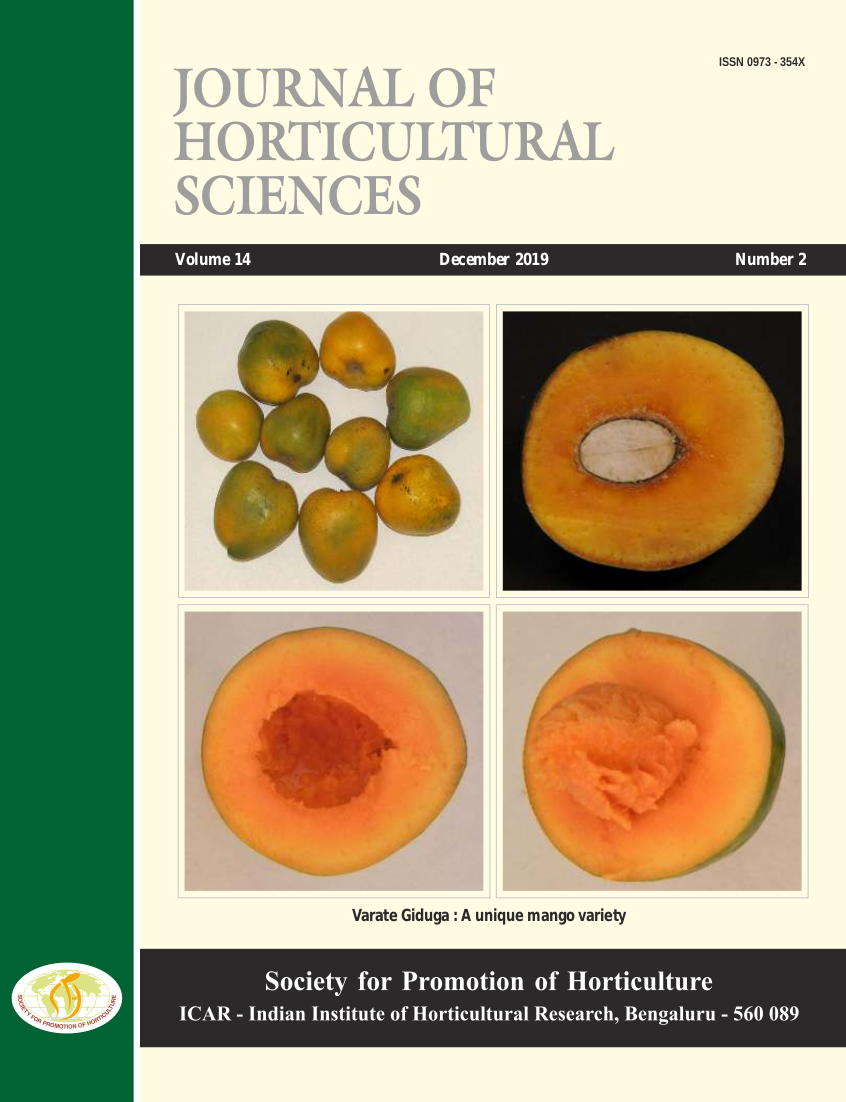Comparative studies on growth and Yield of Conventional and Tissue culture plants of Turmeric (Curcuma longa) var. CO2
DOI:
https://doi.org/10.24154/jhs.v14i2.802Keywords:
Conventional propagation, Rhizome yield, Tissue culture plants, TurmericAbstract
Turmeric (Curcuma longa L.) is an ancient spice, native of India and South East Asia used from antiquity as spice and a dye. It is commonly propagated through rhizomes. The availability of disease free quality planting material is scarce during the cropping season (June – September). An experiment was conducted to study the performance of in vitro derived turmeric plants with conventional rhizome under field condition. The results indicated that the tissue culture plants showed better performance over the conventional rhizome planting. Tissue culture plants grew vigorously and taller than conventional type. The highest yield potential was observed in tissue cultureplants (40.83 tons/ha) as compared to the conventional rhizome planting (30.14 tons/ha). The rhizome rot incidence was lower (3.87% ) in tissue culture plants than rhizome-derived plants (25.58% ). However, the agronomic traits observed during the present study in tissue culture plants are stable and rhizome harvested from tissue culture plants can be used as disease free planting materials for further planting.
Downloads
References
Balachandran, S.M., Bhat, S.R. and Chandel, K.P.S. 1990. In vitro clonal multiplication of turmeric (Curcuma spp) and ginger (Zingiberofficinale Rosc.). Plant Cell Rep., 8: 521-4.
Beruto, M., Cane, G. and Debergh, P. 1996. Field performance of tissue cultured plants of Ranunculus asiaticus L. Sci. Hortic., 66:229-239.
Chattopadhyay, I., Biswas, K., Bandyopadhyay, U.and Banarjee, R.K. 2004. Turmeric and curcumin biological actions and medical applications. Current Sci., 87: 44-53.
CheethaparambilA., Geetha, S.P. and Indira,B. 2014. In vitro microrhizome and minirhizome production in turmeric (Curcuma longa L.) cultivar Alleppey Supreme and its comparative anatomical and histochemical analysis. Int.J.Curr.Microbiol.App.Sci., 3(3): 535-542.
Dirk, R.V. and Rodomiro, O. 1996. Field performance of conventional vsin vitro propagules of plantain (Musa spp., AAB Group). HortSci.,31(5):862-865.
Hwang, S.C., Chen, C.L., Lin, J.C. and Lin, H.L. 1984. Cultivation of banana using plantlets from meristem culture. HortSci.,19: 231-233.
Israeli, Y., Reuveni, O. and Nameri, N. 1988. Genetic variability and performance of In vitro propagated banana plants. In: Memoria de la IV congreso international sobre agrofisiologia del banana. Eds. C.J.A. Guzman and C.R. Romero,
San Jose, Costa Rica.pp. 94-104
Larkin, P.J. and Scowcroft, W.R. 1981. Somaclonal variation - a novel source of variability from cell cultures for plant improvement. Theor. Appl. Genet.,60:197-214.
Neeta, D., Salvi, L.G. and Susan, E. 2002. Micropropagation and field evaluation of micropropagated plants of turmeric. Plant Cell Tiss. Organ Cult.,68:143-151.
Nirmal Babu, K., Minoo, D., Geetha, S.P., Sumathi, V. and Praveen, K. 2007.Biotechnology of turmeric and related species In: Turmeric – The genus Curcuma.ed. Ravindran,P.N., Nirmal Babu, K.and Sivaraman, K., CRC Press, Boca Raton, USA.Pp- 107-125
Samir, C.D. 2007. Influence of indole-3-butyric acid and propagation method on growth and development of in vitro and ex vitro-derived lowbush blueberry plants. Plant. Growth Regul. 51:245-253.
Sheela, V.L. and Ramachandran, N. 2001. Growth, flowering and yield potential of tissue culture banana (musa aab cv. Nendran). J. Trop. Agric., 39:1-4.
Singh, D., Devala, D.K., Punyarani, K.S., Henary, S.C., Brojendro, S.S., Brajakishor, S.C. and Sunitibala, D.H. 2012. Silver nitrate and different culture vessels influence high frequency microrhizome induction in vitro and enhancement growth of turmeric plantlet during ex vitro acclimatization. Nat. Sci. Biol. 4(4):67-78.
Smith, M.K. 1988. A review of factors influencing the genetic stability of micropropagated bananas. Fruits 43:219-223.
Smith, M.K. and Drew, R.A. 1990. Current applications of tissue culture in plant propagation and improvement. Aust. J. Plant. Physiol. 17:267- 289.
Smith, M.K. and Hamil, S.D. 1996. Field evaluation of micropropagated ginger in subtropical Queensland. Aust. J. Exp. Agric. 36:347-354.
Stephens, P.A., Barwale-Zehr, U.B., Nickell, C.D. and Widholm, J.M. 1991. A cytoplasmically-inherited, wrinkled-leaf mutant in soybean. J. Hered. 82:71- 73.
Vuylsteke, D.R., Swennen, G.F. and Wilson Langhe, E. De. 1988. Phenotypic variation among in vitro propagated plantain (Musa spp. cv. AAB). Sci. Hortic. 36: 79-88.
Downloads
Published
Issue
Section
License
Copyright (c) 2019 Chitra R (Author)

This work is licensed under a Creative Commons Attribution-NonCommercial-ShareAlike 4.0 International License.
Authors retain copyright. Articles published are made available as open access articles, distributed under the terms of the Creative Commons Attribution-NonCommercial-ShareAlike 4.0 International License, which permits unrestricted non-commercial use, distribution, and reproduction in any medium, provided the original author and source are credited. 
This journal permits and encourages authors to share their submitted versions (preprints), accepted versions (postprints) and/or published versions (publisher versions) freely under the CC BY-NC-SA 4.0 license while providing bibliographic details that credit, if applicable.












 .
. 











